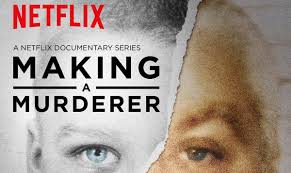Making a Murderer makes waves on Netflix

Photo credit: Forbes
January 17, 2016
Netflix’s Making a Murderer weaves a chilling tale of corruption and conspiracy in the Manitowoc County Sheriff’s Department and illuminates a web of lies that has ruined the life of Steven Avery. But this series is real—it isn’t a tale of conflict built around Matthew McConaughey’s molasses-thick accent or the signature theme song of Law and Order. Much like its podcast counterpart, Sarah Koenig’s incredibly successful true-crime podcast Serial, this documentary calls into question a high-profile conviction and has built a tide of support for the now convicted murderer Steven Avery.
The show lacks much visual appeal, and instead lies on the impact of its message to keep its viewers hooked. There is no attractive leading man or brooding blonde investigator a la ADA Amanda Rollins in Law and Order, but the web of lies exposed in the show’s ten episodes will be the only thing necessary to entrap viewers into a day-long binge session.
Avery’s case made national headlines, and he became a household name in the Midwest. His plight belonged on the silver screen: a man who serving time on a 32-year prison sentence for a brutal attack is exonerated, only to be charged with a suspicious murder charge as soon as he begins to make ground in a suit against local law enforcement for millions of dollars.
Needless to say, his story was made for the spotlight.
Like most documentaries of its type, Making a Murderer has a self-serving bias. The evidence that it argues, while damning in its own right, is not the full story. In fact, viewers are only presented with evidence that can be explained away, and does have a strong undercurrent of doubt. While all that should be necessary is reasonable doubt, which is undoubtedly achieved in the suspicious circumstances shrouding his swift arrest and prosecution for the murder of Teresa Halbach, in neglecting to address some of the evidence used against Avery for the charges (including that of the ballistics of bullets used in the crime matching his gun) the documentary undermines its purpose in highlighting the innocence of a man abused by our Goliath of a justice system.
The series doesn’t rely on a great score or sharp special effects. It is bare, the only visuals being flutt-free shots such as that of the Avery compound, the county prison, and clips of interviews and the trials. However, these scenes still leave you on the edge of your seat. Your heart will still race when instead of seeing a blood-filled climax circa The Walking Dead, you see a single tampered with drop of blood in evidence.
While the Avery case itself is on shaky ground, the documentary succeeds in instead casting doubt on the justice system as a whole. We all stand as a David in its shadow, our freedoms coming underfoot with a single decision, one single person, in a police department determining our guilt. The sheriff’s department of Manitowoc county didn’t wear a mask or wield a gun, but its actions were just as devastating when it took the law into its own hands and decided to play God. In this way, Making a Murderer is the most frightening “scary movie” on Netflix, because any one of us could be Steven Avery.











